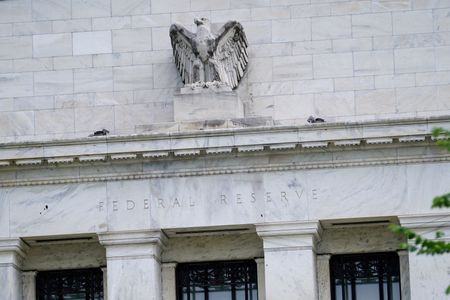By Howard Schneider
WASHINGTON (Reuters) – Weaker U.S. productivity gains in the first quarter may challenge the Federal Reserve’s efforts to finish its inflation fight without a painful rise in unemployment, potentially stalling progress on prices absent a further economic slowdown.
A jump last year in how much workers produce helped the economy grow fast and hiring remain strong while inflation fell nonetheless. Data for the first three months of 2024, however, showed worker productivity rose at a 0.3% annual pace, compared to increases of more than 3% in the prior three quarters.
Unit labor costs, as a result, jumped 4.7%, the fastest in a year, as businesses spread higher wage and benefit payments across a comparatively small boost in what each person produced.
Analysts said the first-quarter results don’t on their own disrupt what has been a core reason for optimism that the U.S. was heading for a “soft landing” in which inflation would return to the Fed’s 2% target without the sort of sharp rise in joblessness associated with past battles against rising prices.
Productivity numbers are volatile, they noted, and even those reported for the first quarter leave a stronger yearly trend intact with reason to believe there will be further improvements.
But it also keeps alive the question of how much the Fed can count on additional improvement in the economy’s ability to supply goods and services to help in the inflation fight, and how much will now rest on curbing demand – potentially dealing a blow to employment in the process.
Fed Chair Jerome Powell was sensitive to the issue during a press conference on Wednesday after the Fed held its benchmark interest rate steady in the current 5.25%-5.50% range while acknowledging that improvement in inflation had slowed and would require borrowing costs to remain high.
He said he still believes inflation can be returned to the Fed’s target “without significant dislocations in the labor market or elsewhere.”
Supply-side improvements, including higher productivity and faster immigration, “really helped inflation come down … I’m not giving up on that. I think it is possible those forces will still work to help us,” Powell said.
But, he added, there was no guarantee, and at the very least the process “will take longer than previously expected.”
JOBS DATA
The U.S. Labor Department will release its employment report for April on Friday, providing the latest touchpoint for central bankers to assess whether the economy is moving towards a more sustainable pace of job and wage growth, as many feel it is.
Results for March from the Job Openings and Labor Turnover Survey, for example, showed balance continuing to emerge between the availability of workers and the demand for them. Economists polled by Reuters expect firms hired an additional 243,000 workers in April, continuing a pandemic-era streak of job gains that a rising number of foreign-born workers has helped sustain even as wage growth moderates.
The unemployment rate has been below 4% for 26 months, a run not seen since the late 1960s.
The Fed doesn’t want to wreck that streak, and the thinking under Powell has shifted away from what had been a working assumption that a low jobless rate stokes inflation to a more open-ended “show-me” attitude.
The approach served the Fed well last year. Inflation fell sharply from the 40-year highs hit in 2022 even though the unemployment rate remained at levels that would, in some assessments of the U.S. economy, have kept price pressures elevated. Even amid calls from top ranking economists that the unemployment rate had to rise for inflation to fall, the central bank unveiled its last rate hike in July.
But if “disinflation” loses steam it could make the Fed’s endgame more difficult.
For now, Powell said the central bank is content to be patient and allow the current policy rate to do its work.
In the opening statement of his press conference on Wednesday, he excluded a phrase he had used in January and March that “it will likely be appropriate to begin dialing back policy restraint at some point this year,” cementing a shift in expectations for steady and substantial rate cuts this year to doubt about whether rates will fall at all.
The change in Powell’s language has touched off a mini-cycle of financial tightening across credit markets, with the average rate on a 30-year fixed-rate home mortgage jumping back above 7% and yields on the 2-year U.S. Treasury note, considered a proxy for Fed policy, rising from roughly 4.2% in January to around 5% now.
Powell said this week that these trends will all eventually show up in the form of inflation falling towards 2% from a level that, based on the Fed’s preferred inflation measure, was running at 2.7% in March.
But how long that journey takes and what happens to workers in the meantime will depend on factors – productivity among them – well outside the central bank’s control.
The Fed may not be willing to risk damaging the economy with further rate hikes to achieve the last bit of inflation control. But neither, Powell said, will policymakers rush to cut rates over a modest rise in unemployment.
“It would have to be a meaningful thing and get our attention and lead us to think the labor market was really significantly weakening” he said on Wednesday. “A couple of tenths (of a percentage point) in the unemployment rate would probably not do that.”
(Reporting by Howard Schneider; Editing by Paul Simao)











